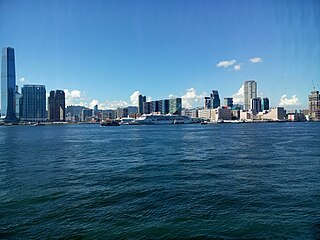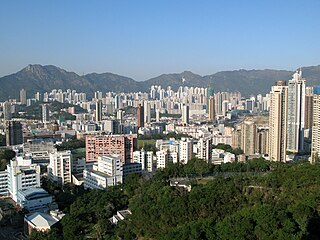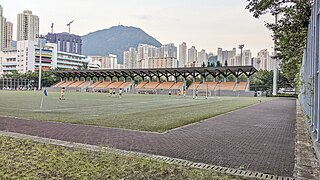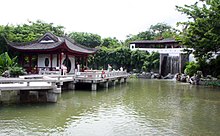
Kowloon is an urban area in Hong Kong comprising the Kowloon Peninsula and New Kowloon. It has a population of 2,019,533 and a population density of 43,033/km2 (111,450/sq mi) in 2006. It is one of the three regions of Hong Kong, along with Hong Kong Island and the New Territories, and is the smallest and most densely populated.

Kowloon Walled City was an extremely densely populated and largely ungoverned enclave of China within the boundaries of Kowloon City, British Hong Kong.

The Hong Kong Zoological and Botanical Gardens is one of the oldest zoological and botanical centres in the world, and the oldest park in Hong Kong. Founded in 1864, its first stage was opened to the public in 1871. It occupies an area of 5.6 hectares, in Central, on the northern slope of Victoria Peak.

Hong Kong City Hall is a building located at Edinburgh Place, Central, Hong Kong Island, Hong Kong.

The Hong Kong Space Museum is a public astronomy and space science museum located in Tsim Sha Tsui, Hong Kong. Opened on 8 October 1980, it is managed by the Leisure and Cultural Services Department of the Hong Kong Government. The building is notable for its hemispherical shape, which contains a planetarium, the only one in Hong Kong. The main facilities of the museum are located in a building next to the planetarium, showcasing information about the Solar System, cosmology, and spaceflight.

Kowloon Park is a large public park in Tsim Sha Tsui, Kowloon, Hong Kong. It has an area of 13.3 hectares and is managed by the Leisure and Cultural Services Department.

The Leisure and Cultural Services Department (LCSD), is a department in the Government of Hong Kong. It reports to the Culture, Sports & Tourism Bureau, headed by the Secretary for Culture, Sports and Tourism. It provides leisure and cultural activities for the people of Hong Kong, which was also one of the tasks of the former Urban Council, and Regional Council and Home Affairs Bureau. It manages various public facilities around Hong Kong including public libraries, swimming pools, and sports centres. The well-known Hong Kong Cultural Centre and Hong Kong Space Museum are among several museums also managed by the department. It was established in 2000 and its headquarters is in Shatin, New Territories.

The Hong Kong Public Libraries is a system of 70 static and 12 mobile public libraries in Hong Kong. Offering a total collection of 14.35 million items, the system is managed by the Leisure and Cultural Services Department. The network of libraries are interconnected by a computerised library management system, one of the largest bilingual systems in the world, offering both Chinese and English capabilities.

Kowloon City District is one of the 18 districts of Hong Kong. It is located in the city of Kowloon. It had a population of 381,352 in 2001, and increased to 418,732 in 2016. The district has the third most educated residents while its residents enjoy the highest income in Kowloon. It borders all the other districts in Kowloon, with Kwun Tong district to the east, Wong Tai Sin district to its northeast, Sham Shui Po district to its northwest, and Yau Tsim Mong district to its southwest.

Kowloon Tsai Park is a park located in the Kowloon Tsai area of New Kowloon in Hong Kong. It lies within the Kowloon City District and opened on 5 June 1964.

The 2009 East Asian Games, officially known as the V East Asian Games, was an international multi-sport event that hosted by Hong Kong, between 5 December and 13 December 2009. A total of 2,377 athletes from 9 East Asian national competed in 262 events in 22 sports. It was the biggest sporting event ever held in the territory.

The Kowloon Public Library is a public library located in Ho Man Tin, Hong Kong. It was previously known as the Kowloon Central Library. It is managed by the Leisure and Cultural Services Department (LCSD), and is one of the major public libraries in Hong Kong. The 12-storey building comprises about 4,000 square metres (43,000 sq ft) of floor space.

Kowloon Bay Sports Ground is a multi-purpose sports ground situated in Kowloon Bay, Kowloon, Hong Kong.

The Dr Sun Yat-sen Historical Trail was set up in November 1996 by the Central and Western District Council to commemorate the 130th birthday of Sun Yat-sen. It includes 16 spots in the areas of Central and Sheung Wan in Hong Kong, related to the life of Sun Yat-sen and other revolutionaries in the late Qing era. Originally the Sun Yat-sen Historical Trail had 13 markers; in 2001, it was renovated and renamed, and two spots were added to it. In 2018, the trail was further updated under a Revitalization Project, where artists were commissioned by the government to create art at each location.

Kowloon Bay Park is a public park in Kowloon Bay, Kowloon, Hong Kong. The park is managed by Leisure and Cultural Services Department. It was opened on 30 March 2005.
The Hong Kong Dragon Garden is an 8 hectares private heritage garden located at No. 32-42 Castle Peak Road, Tsing Lung Tau, in the backdrop of Sham Tseng in the west of the Tsuen Wan District in the New Territories of Hong Kong, founded by Lee Iu-cheung.

Public swimming pools in Hong Kong are managed by the Leisure and Cultural Services Department (LCSD). There are 44 public swimming pools in Hong Kong; 9 in Hong Kong Island, 13 in Kowloon, and 22 in the New Territories. LCSD manages public swimming pools according to Law of Hong Kong Chapter 132 sections 42 to 45.

The Kowloon Park Swimming Pool, located in Tsim Sha Tsui, Kowloon, is one of the most heavily used swimming pool complexes in Hong Kong, serving over 2,000 swimmers daily. It includes four indoor heated pools, including an Olympic sized 50-metre main pool, two 25-metre training pools, and a 20-metre diving pool. There are also several outdoor leisure pools.

Chu Tat-shing is a Chinese sculptor and visual artist. He is known for his sculpture of Bruce Lee at the Hong Kong Heritage Museum. He has also made sculptures of Sun Yat-sen on display in Hong Kong and Hawaii. The sculptures at the SARS Memorial in Hong Kong Park were made by him.























